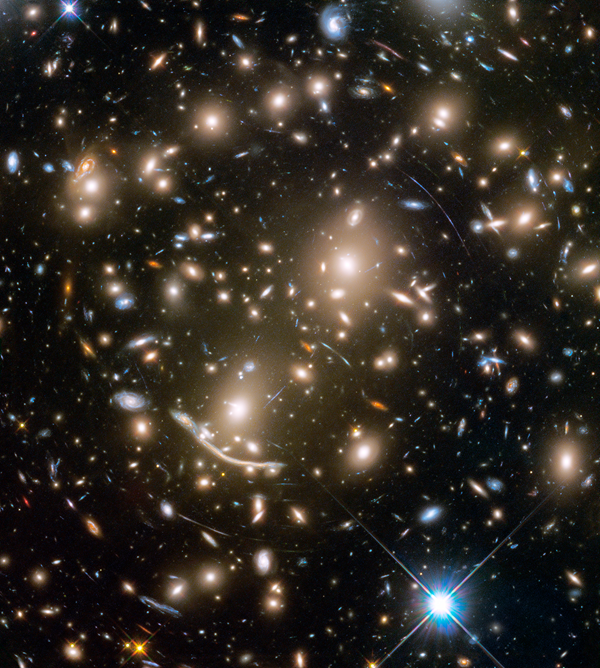Massive galaxy clusters offer astronomers some amazing opportunities to study several aspects of the universe around us. From tracing close interactions between galaxies to using the cluster as a lens through which to view distant objects, high-quality images of these clusters provide valuable insight. Hubble’s recent image of the galaxy cluster Abell 370 illustrates the value in such images beautifully.
Abell 370 is one of thousands of galaxy clusters originally compiled into a catalog by George Abell in 1958. The initial catalog included nearly 3,000 galaxy clusters visible in the Northern Hemisphere, and was updated in 1989 to include Southern Hemisphere clusters as well. At a distance of 4 billion light-years, Abell 370 is the most distant galaxy cluster in the catalog, but not the most distant cluster we’ve discovered. And even at this great distance, Abell 370 allows astronomers to probe galaxies that are even more distant through a phenomenon called gravitational lensing.
Gravitational lensing occurs when a massive object — such as a galaxy cluster, rich in galaxies, gas, and dark matter — sits in front of another object as viewed from Earth. The gravity of the cluster bends space in its vicinity, much like a bowling ball depresses a mattress. When the light encounters the “bend” in space, it’s bent as well, traveling around the cluster before it continues its journey to Earth. As a result, the light is both magnified and smeared out, creating arcs attributable to galaxies in the far background when the cluster is imaged. One of the best examples of this in Abell 370 is a feature called “the Dragon,” visible as a smeared trail streaming behind a spiral galaxy to the lower left of the center.
The Milky Way resides in a group of galaxies, aptly called the Local Group. Our Local Group contains a few tens of galaxies (somewhere between 30-50 or so), and could be considered a relatively small hamlet in the larger scheme of things. But huge galaxy clusters like Abell 370 contain hundreds of galaxies or more, many of which reside in their dense centers.
Massive galaxy clusters also tend to accumulate their most massive and oldest galaxies in the center; these galaxies can be easily spotted by eye as yellow-red fuzzy spots, called elliptical galaxies. Unlike the Milky Way and Andromeda, which are spiral galaxies, elliptical galaxies don’t have arms and typically don’t have any blue (young) stars; they’re also relatively devoid of dust and gas. Spiral galaxies tend to be bluer in color because they contain younger stars; they also contain more dust and gas, which gives rise to some of their most visually striking features.
This image of Abell 370 was taken as part of the recently concluded Frontier Fields project, with a goal of observing objects otherwise too far off to see by taking advantage of gravitational lensing around massive galaxy clusters. Viewing these very far-off, very young galaxies sheds light on how galaxies formed and evolved in the early universe. The project has thus far allowed astronomers to glimpse galaxies up to 100 times fainter than previously seen.










